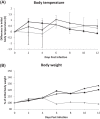Avian influenza H7N9/13 and H7N7/13: a comparative virulence study in chickens, pigeons, and ferrets
- PMID: 24899194
- PMCID: PMC4136250
- DOI: 10.1128/JVI.01241-14
Avian influenza H7N9/13 and H7N7/13: a comparative virulence study in chickens, pigeons, and ferrets
Abstract
Human influenza cases caused by a novel avian H7N9 virus in China emphasize the zoonotic potential of that subtype. We compared the infectivity and pathogenicity of the novel H7N9 virus with those of a recent European avian H7N7 strain in chickens, pigeons, and ferrets. Neither virus induced signs of disease despite substantial replication in inoculated chickens and rapid transmission to contact chickens. Evidence of the replication of both viruses in pigeons, albeit at lower levels of RNA excretion, was also detected. No clear-cut differences between the two H7 isolates emerged regarding replication and antibody development in avian hosts. In ferrets, in contrast, greater replication of the avian H7N9 virus than of the H7N7 strain was observed with significant differences in viral presence, e.g., in nasal wash, lung, and cerebellum samples. Importantly, both viruses showed the potential to spread to the mammal brain. We conclude that efficient asymptomatic viral replication and shedding, as shown in chickens, facilitate the spread of H7 viruses that may harbor zoonotic potential. Biosafety measures are required for the handling of poultry infected with avian influenza viruses of the H7 subtype, independently of their pathogenicity for gallinaceous poultry.
Importance: This study is important to the field since it provides data about the behavior of the novel H7N9 avian influenza virus in chickens, pigeons, and ferrets in comparison with that of a recent low-pathogenicity H7N7 strain isolated from poultry. We clearly show that chickens, but not pigeons, are highly permissive hosts of both H7 viruses, allowing high-titer replication and virus shedding without any relevant clinical signs. In the ferret model, the potential of both viruses to infect mammals could be demonstrated, including infection of the brain. However, the replication efficiency of the H7N9 virus in ferrets was higher than that of the H7N7 strain. In conclusion, valuable data for the risk analysis of low-pathogenicity avian influenza viruses of the H7 subtype are provided that could also be used for the risk assessment of zoonotic potentials and necessary biosafety measures.
Copyright © 2014, American Society for Microbiology. All Rights Reserved.
Figures



References
-
- Gao R, Cao B, Hu Y, Feng Z, Wang D, Hu W, Chen J, Jie Z, Qiu H, Xu K, Xu X, Lu H, Zhu W, Gao Z, Xiang N, Shen Y, He Z, Gu Y, Zhang Z, Yang Y, Zhao X, Zhou L, Li X, Zou S, Zhang Y, Li X, Yang L, Guo J, Dong J, Li Q, Dong L, Zhu Y, Bai T, Wang S, Hao P, Yang W, Zhang Y, Han J, Yu H, Li D, Gao GF, Wu G, Wang Y, Yuan Z, Shu Y. 2013. Human infection with a novel avian-origin influenza A (H7N9) virus. N. Engl. J. Med. 368:1888–1897. 10.1056/NEJMoa1304459 - DOI - PubMed
-
- Chen Y, Liang W, Yang S, Wu N, Gao H, Sheng J, Yao H, Wo J, Fang Q, Cui D, Li Y, Yao X, Zhang Y, Wu H, Zheng S, Diao H, Xia S, Zhang Y, Chan KH, Tsoi HW, Teng JL, Song W, Wang P, Lau SY, Zheng M, Chan JF, To KK, Chen H, Li L, Yuen KY. 2013. Human infections with the emerging avian influenza A H7N9 virus from wet market poultry: clinical analysis and characterisation of viral genome. Lancet 381:1916–1925. 10.1016/S0140-6736(13)60903-4 - DOI - PMC - PubMed
-
- Li Q, Zhou L, Zhou M, Chen Z, Li F, Wu H, Xiang N, Chen E, Tang F, Wang D, Meng L, Hong Z, Tu W, Cao Y, Li L, Ding F, Liu B, Wang M, Xie R, Gao R, Li X, Bai T, Zou S, He J, Hu J, Xu Y, Chai C, Wang S, Gao Y, Jin L, Zhang Y, Luo H, Yu H, Gao L, Pang X, Liu G, Shu Y, Yang W, Uyeki TM, Wang Y, Wu F, Feng Z. 24 April 2013. Preliminary report: epidemiology of the avian influenza A (H7N9) outbreak in China. N. Engl. J. Med. 10.1056/NEJMoa1304617 - DOI - PubMed
-
- Shi J, Deng G, Liu P, Zhou J, Guan L, Li W, Li X, Guo J, Wang G, Fan J, Wang J, Li Y, Jiang Y, Liu L, Tian G, Li C, Chen H. 2013. Isolation and characterization of H7N9 viruses from live poultry markets—implication of the source of current H7N9 infection in humans. Chin. Sci. Bull. 58:7. 10.1007/s11434-012-5577-1 - DOI
-
- Kageyama T, Fujisaki S, Takashita E, Xu H, Yamada S, Uchida Y, Neumann G, Saito T, Kawaoka Y, Tashiro M. 2013. Genetic analysis of novel avian A(H7N9) influenza viruses isolated from patients in China, February to April 2013. Euro Surveill. 18:20459 http://www.eurosurveillance.org/ViewArticle.aspx?ArticleId=20453 - PMC - PubMed
Publication types
MeSH terms
Substances
LinkOut - more resources
Full Text Sources
Other Literature Sources
Medical

